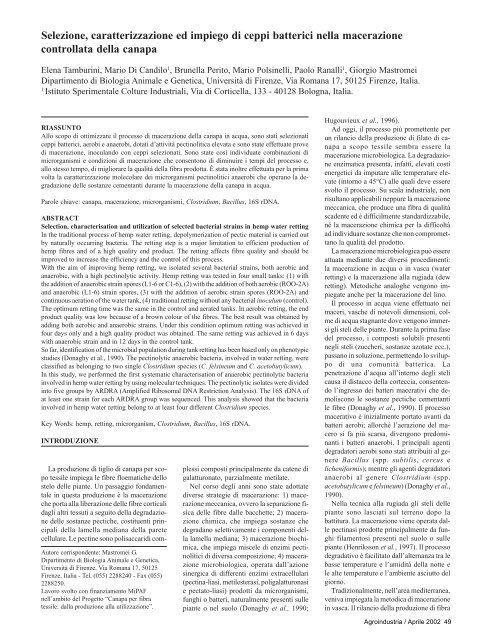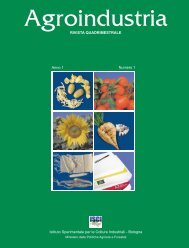Istituto Sperimentale per le Colture Industriali - Bologna ... - isci.it
Istituto Sperimentale per le Colture Industriali - Bologna ... - isci.it
Istituto Sperimentale per le Colture Industriali - Bologna ... - isci.it
Create successful ePaper yourself
Turn your PDF publications into a flip-book with our unique Google optimized e-Paper software.
Se<strong>le</strong>zione, caratterizzazione ed impiego di ceppi batterici nella macerazione<br />
controllata della canapa<br />
E<strong>le</strong>na Tamburini, Mario Di Candilo 1 , Brunella Per<strong>it</strong>o, Mario Polsinelli, Paolo Ranalli 1 , Giorgio Mastromei<br />
Dipartimento di Biologia Anima<strong>le</strong> e Genetica, Univers<strong>it</strong>à di Firenze, Via Romana 17, 50125 Firenze, Italia.<br />
1 <strong>Ist<strong>it</strong>uto</strong> <strong>S<strong>per</strong>imenta<strong>le</strong></strong> <strong>Colture</strong> <strong>Industriali</strong>, Via di Corticella, 133 - 40128 <strong>Bologna</strong>, Italia.<br />
RIASSUNTO<br />
Allo scopo di ottimizzare il processo di macerazione della canapa in acqua, sono stati se<strong>le</strong>zionati<br />
ceppi batterici, aerobi e anaerobi, dotati d’attiv<strong>it</strong>à pectinol<strong>it</strong>ica e<strong>le</strong>vata e sono state effettuate prove<br />
di macerazione, inoculando con ceppi se<strong>le</strong>zionati. Sono state così individuate combinazioni di<br />
microrganismi e condizioni di macerazione che consentono di diminuire i tempi del processo e,<br />
allo stesso tempo, di migliorare la qual<strong>it</strong>à della fibra prodotta. È stata inoltre effettuata <strong>per</strong> la prima<br />
volta la caratterizzazione mo<strong>le</strong>colare dei microrganismi pectinol<strong>it</strong>ici anaerobi che o<strong>per</strong>ano la degradazione<br />
del<strong>le</strong> sostanze cementanti durante la macerazione della canapa in acqua.<br />
Paro<strong>le</strong> chiave: canapa, macerazione, microrganismi, Clostridium, Bacillus, 16S rDNA.<br />
ABSTRACT<br />
Se<strong>le</strong>ction, characterisation and utilization of se<strong>le</strong>cted bacterial strains in hemp water retting<br />
In the trad<strong>it</strong>ional process of hemp water retting, depolymerization of pectic material is carried out<br />
by naturally occurring bacteria. The retting step is a major lim<strong>it</strong>ation to efficient production of<br />
hemp fibres and of a high qual<strong>it</strong>y end product. The retting affects fibre qual<strong>it</strong>y and should be<br />
improved to increase the efficiency and the control of this process.<br />
W<strong>it</strong>h the aim of improving hemp retting, we isolated several bacterial strains, both aerobic and<br />
anaerobic, w<strong>it</strong>h a high pectinolytic activ<strong>it</strong>y. Hemp retting was tested in four small tanks: (1) w<strong>it</strong>h<br />
the add<strong>it</strong>ion of anaerobic strain spores (L1-6 or C1-6), (2) w<strong>it</strong>h the add<strong>it</strong>ion of both aerobic (ROO-2A)<br />
and anaerobic (L1-6) strain spores, (3) w<strong>it</strong>h the add<strong>it</strong>ion of aerobic strain spores (ROO-2A) and<br />
continuous aeration of the water tank, (4) trad<strong>it</strong>ional retting w<strong>it</strong>hout any bacterial inoculum (control).<br />
The optimum retting time was the same in the control and aerated tanks. In aerobic retting, the end<br />
product qual<strong>it</strong>y was low because of a brown colour of the fibres. The best result was obtained by<br />
adding both aerobic and anaerobic strains. Under this cond<strong>it</strong>ion optimum retting was achieved in<br />
four days only and a high qual<strong>it</strong>y product was obtained. The same retting was achieved in 6 days<br />
w<strong>it</strong>h anaerobic strain and in 12 days in the control tank.<br />
So far, identification of the microbial population during tank retting has been based only on phenotypic<br />
studies (Donaghy et al., 1990). The pectinolytic anaerobic bacteria, involved in water retting, were<br />
classified as belonging to two sing<strong>le</strong> Clostridium species (C. felsineum and C. acetobutylicum).<br />
In this study, we <strong>per</strong>formed the first systematic characterisation of anaerobic pectinolytic bacteria<br />
involved in hemp water retting by using mo<strong>le</strong>cular techniques. The pectinolytic isolates were divided<br />
into five groups by ARDRA (Amplified Ribosomal DNA Restriction Analysis). The 16S rDNA of<br />
at <strong>le</strong>ast one strain for each ARDRA group was sequenced. This analysis showed that the bacteria<br />
involved in hemp water retting belong to at <strong>le</strong>ast four different Clostridium species.<br />
Key Words: hemp, retting, microrganism, Clostridium, Bacillus, 16S rDNA.<br />
INTRODUZIONE<br />
La produzione di tiglio di canapa <strong>per</strong> scopo<br />
tessi<strong>le</strong> impiega <strong>le</strong> fibre floematiche dello<br />
stelo del<strong>le</strong> piante. Un passaggio fondamenta<strong>le</strong><br />
in questa produzione è la macerazione<br />
che porta alla liberazione del<strong>le</strong> fibre corticali<br />
dagli altri tessuti a segu<strong>it</strong>o della degradazione<br />
del<strong>le</strong> sostanze pectiche, cost<strong>it</strong>uenti principali<br />
della lamella mediana della parete<br />
cellulare. Le pectine sono polisaccaridi com-<br />
Autore corrispondente: Mastromei G.<br />
Dipartimento di Biologia Anima<strong>le</strong> e Genetica,<br />
Univers<strong>it</strong>à di Firenze, Via Romana 17, 50125<br />
Firenze, Italia - Tel. (055) 2288240 - Fax (055)<br />
2288250.<br />
Lavoro svolto con finanziamento MiPAF<br />
nell’amb<strong>it</strong>o del Progetto “Canapa <strong>per</strong> fibra<br />
tessi<strong>le</strong>: dalla produzione alla utilizzazione”.<br />
p<strong>le</strong>ssi composti principalmente da catene di<br />
galatturonato, parzialmente metilate.<br />
Nel corso degli anni sono state adottate<br />
diverse strategie di macerazione: 1) macerazione<br />
meccanica, ovvero la separazione fisica<br />
del<strong>le</strong> fibre dal<strong>le</strong> bacchette; 2) macerazione<br />
chimica, che impiega sostanze che<br />
degradano se<strong>le</strong>ttivamente i componenti della<br />
lamella mediana; 3) macerazione biochimica,<br />
che impiega misce<strong>le</strong> di enzimi pectinol<strong>it</strong>ici<br />
di diversa composizione; 4) macerazione<br />
microbiologica, o<strong>per</strong>ata dall’azione<br />
sinergica di differenti enzimi extracellulari<br />
(pectina-liasi, meti<strong>le</strong>sterasi, poligalatturonasi<br />
e pectato-liasi) prodotti da microrganismi,<br />
funghi o batteri, naturalmente presenti sul<strong>le</strong><br />
piante o nel suolo (Donaghy et al., 1990;<br />
Hugouvieux et al., 1996).<br />
Ad oggi, il processo più promettente <strong>per</strong><br />
un rilancio della produzione di filato di canapa<br />
a scopo tessi<strong>le</strong> sembra essere la<br />
macerazione microbiologica. La degradazione<br />
enzimatica presenta, infatti, e<strong>le</strong>vati costi<br />
energetici da imputare al<strong>le</strong> tem<strong>per</strong>ature e<strong>le</strong>vate<br />
(intorno a 45°C) al<strong>le</strong> quali deve essere<br />
svolto il processo. Su scala industria<strong>le</strong>, non<br />
risultano applicabili neppure la macerazione<br />
meccanica, che produce una fibra di qual<strong>it</strong>à<br />
scadente ed è difficilmente standardizzabi<strong>le</strong>,<br />
né la macerazione chimica <strong>per</strong> la difficoltà<br />
ad individuare sostanze che non compromettano<br />
la qual<strong>it</strong>à del prodotto.<br />
La macerazione microbiologica può essere<br />
attuata mediante due diversi procedimenti:<br />
la macerazione in acqua o in vasca (water<br />
retting) e la macerazione alla rugiada (dew<br />
retting). Metodiche analoghe vengono impiegate<br />
anche <strong>per</strong> la macerazione del lino.<br />
Il processo in acqua viene effettuato nei<br />
maceri, vasche di notevoli dimensioni, colme<br />
di acqua stagnante dove vengono immersi<br />
gli steli del<strong>le</strong> piante. Durante la prima fase<br />
del processo, i composti solubili presenti<br />
negli steli (zuccheri, sostanze azotate ecc.),<br />
passano in soluzione, <strong>per</strong>mettendo lo sviluppo<br />
di una comun<strong>it</strong>à batterica. La<br />
penetrazione d’acqua all’interno degli steli<br />
causa il distacco della corteccia, consentendo<br />
l’ingresso dei batteri macerativi che demoliscono<br />
<strong>le</strong> sostanze pectiche cementanti<br />
<strong>le</strong> fibre (Donaghy et al., 1990). Il processo<br />
macerativo è inizialmente portato avanti da<br />
batteri aerobi; allorché l’aerazione del macero<br />
si fa più scarsa, divengono predominanti<br />
i batteri anaerobi. I principali agenti<br />
degradatori aerobi sono stati attribu<strong>it</strong>i al genere<br />
Bacillus (spp. subtilis, cereus e<br />
licheniformis); mentre gli agenti degradatori<br />
anaerobi al genere Clostridium (spp.<br />
acetobutylicum e felsineum) (Donaghy et al.,<br />
1990).<br />
Nella tecnica alla rugiada gli steli del<strong>le</strong><br />
piante sono lasciati sul terreno dopo la<br />
batt<strong>it</strong>ura. La macerazione viene o<strong>per</strong>ata dal<strong>le</strong><br />
pectinasi prodotte principalmente da funghi<br />
filamentosi presenti nel suolo o sul<strong>le</strong><br />
piante (Henriksson et al., 1997). Il processo<br />
degradativo è facil<strong>it</strong>ato dall’alternanza tra <strong>le</strong><br />
basse tem<strong>per</strong>ature e l’umid<strong>it</strong>à della notte e<br />
<strong>le</strong> alte tem<strong>per</strong>ature e l’ambiente asciutto del<br />
giorno.<br />
Tradizionalmente, nell’area med<strong>it</strong>erranea,<br />
veniva impiegata la metodica di macerazione<br />
in vasca. Il rilancio della produzione di fibra<br />
Agroindustria / Apri<strong>le</strong> 2002 49



